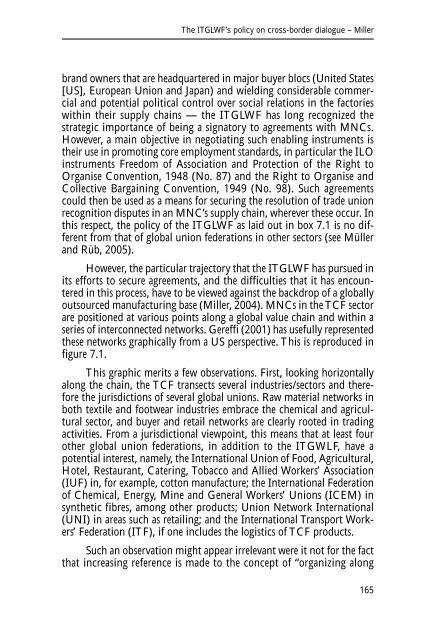CROSS-BORDER SOCIAL DIALOGUE AND AGREEMENTS: An ...
CROSS-BORDER SOCIAL DIALOGUE AND AGREEMENTS: An ...
CROSS-BORDER SOCIAL DIALOGUE AND AGREEMENTS: An ...
You also want an ePaper? Increase the reach of your titles
YUMPU automatically turns print PDFs into web optimized ePapers that Google loves.
The ITGLWF’s policy on cross-border dialogue – Miller<br />
brand owners that are headquartered in major buyer blocs (United States<br />
[US], European Union and Japan) and wielding considerable commercial<br />
and potential political control over social relations in the factories<br />
within their supply chains — the ITGLWF has long recognized the<br />
strategic importance of being a signatory to agreements with MNCs.<br />
However, a main objective in negotiating such enabling instruments is<br />
their use in promoting core employment standards, in particular the ILO<br />
instruments Freedom of Association and Protection of the Right to<br />
Organise Convention, 1948 (No. 87) and the Right to Organise and<br />
Collective Bargaining Convention, 1949 (No. 98). Such agreements<br />
could then be used as a means for securing the resolution of trade union<br />
recognition disputes in an MNC’s supply chain, wherever these occur. In<br />
this respect, the policy of the ITGLWF as laid out in box 7.1 is no different<br />
from that of global union federations in other sectors (see Müller<br />
and Rüb, 2005).<br />
However, the particular trajectory that the ITGLWF has pursued in<br />
its efforts to secure agreements, and the difficulties that it has encountered<br />
in this process, have to be viewed against the backdrop of a globally<br />
outsourced manufacturing base (Miller, 2004). MNCs in the TCF sector<br />
are positioned at various points along a global value chain and within a<br />
series of interconnected networks. Gereffi (2001) has usefully represented<br />
these networks graphically from a US perspective. This is reproduced in<br />
figure 7.1.<br />
This graphic merits a few observations. First, looking horizontally<br />
along the chain, the TCF transects several industries/sectors and therefore<br />
the jurisdictions of several global unions. Raw material networks in<br />
both textile and footwear industries embrace the chemical and agricultural<br />
sector, and buyer and retail networks are clearly rooted in trading<br />
activities. From a jurisdictional viewpoint, this means that at least four<br />
other global union federations, in addition to the ITGWLF, have a<br />
potential interest, namely, the International Union of Food, Agricultural,<br />
Hotel, Restaurant, Catering, Tobacco and Allied Workers’ Association<br />
(IUF) in, for example, cotton manufacture; the International Federation<br />
of Chemical, Energy, Mine and General Workers’ Unions (ICEM) in<br />
synthetic fibres, among other products; Union Network International<br />
(UNI) in areas such as retailing; and the International Transport Workers’<br />
Federation (ITF), if one includes the logistics of TCF products.<br />
Such an observation might appear irrelevant were it not for the fact<br />
that increasing reference is made to the concept of “organizing along<br />
165
















